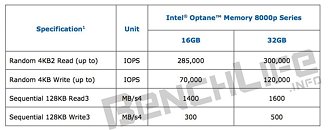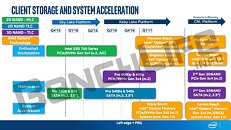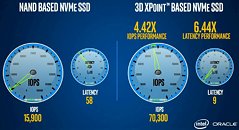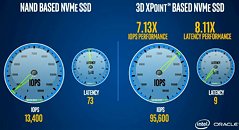Friday, October 14th 2016

Intel 8000p - The First Consumer-Grade 3D Xpoint Products
The Intel-Micron joint collaboration in the development of what is promised to be the next step in storage technology is inching ever closer to reality. According to Bench Life, which published a leaked specifications list for the upcoming Intel Optane Memory products, the first application for consumer-grade 3D XPoint technology straddles the line between an SSD and system RAM. Intel calls it a "System Accelerator" solution, and it's meant to operate as an intermediate caching solution between a system's RAM and storage. Codenamed "Stony Beach", Intel's 8000p (and entire 3D XPoint-based products) support is still up in the air, but it's expected that only Kaby Lake and subsequent platforms will be compatible with the technology - which, if true, is sure to limit the product's market penetration.
The consumer products will initially sport capacities of either 16GB or 32GB, leveraging the NVMe protocol at PCIe Gen 3.0 x2 bandwidth in the M.2 form-factor. Mirroring NAND technology, the greater capacity solution will sport the highest performance: with the 16GB part coming in at 1400 MB/s read and 300 MB/s write speeds, against the 32 GB's 1600 MB/s and 400 MB/s, respectively. We see similar results in regards to IOPS, with the 16GB solution offering up to 285,000 read and 70,000 write operations per second, against the 32 GB's solution respective 300,000 read and 120,000 write. As usual with new technologies, expect all these metrics to only go up in time.This in itself isn't much to talk about - the latest consumer-grade NAND-based SSD solutions already sport read and write speeds comparable to these Intel Optane drives (Samsung's 960 EVO springs to mind). That said, a product's performance can't be solely appraised by the way it looks on paper. As it is, the exact testing conditions that originated these performance ratings are unknown. More specifically, the metrics where 3D XPoint is supposed to excel versus NAND: latency access times, and speed at lower queue depths. And of course, one should not forget the lack of information on what amounts to the leading metric towards general consumer adoption: pricing.
True SSD-class products based on 3D XPoint are expected slightly after Intel's 8000p series, at the very end of 4Q 2016, and 1Q 2017, under the codenames "Mansion Beach" and "Brighton Beach" respectively. Details are close to nonexistent on these products at this time, save for the usage of the NVMe protocol and M.2 form-factor.
Source:
Bench Life
The consumer products will initially sport capacities of either 16GB or 32GB, leveraging the NVMe protocol at PCIe Gen 3.0 x2 bandwidth in the M.2 form-factor. Mirroring NAND technology, the greater capacity solution will sport the highest performance: with the 16GB part coming in at 1400 MB/s read and 300 MB/s write speeds, against the 32 GB's 1600 MB/s and 400 MB/s, respectively. We see similar results in regards to IOPS, with the 16GB solution offering up to 285,000 read and 70,000 write operations per second, against the 32 GB's solution respective 300,000 read and 120,000 write. As usual with new technologies, expect all these metrics to only go up in time.This in itself isn't much to talk about - the latest consumer-grade NAND-based SSD solutions already sport read and write speeds comparable to these Intel Optane drives (Samsung's 960 EVO springs to mind). That said, a product's performance can't be solely appraised by the way it looks on paper. As it is, the exact testing conditions that originated these performance ratings are unknown. More specifically, the metrics where 3D XPoint is supposed to excel versus NAND: latency access times, and speed at lower queue depths. And of course, one should not forget the lack of information on what amounts to the leading metric towards general consumer adoption: pricing.
True SSD-class products based on 3D XPoint are expected slightly after Intel's 8000p series, at the very end of 4Q 2016, and 1Q 2017, under the codenames "Mansion Beach" and "Brighton Beach" respectively. Details are close to nonexistent on these products at this time, save for the usage of the NVMe protocol and M.2 form-factor.




21 Comments on Intel 8000p - The First Consumer-Grade 3D Xpoint Products
My aging XP941 is comparable to those sequential numbers, guess the kicker is the latency here (L4 memory?).
I also notice they have the System Accelerator Gen 2 listed as BGA. I wonder if this will come already soldered on mainboards? That could get the price down enough where it will be useful. We will need more PCIe lanes!
the concept makes a lot of sense when dealing with huge io, like fusio-io (now part of western digital after they bought sandisk) was doing 5 yrs ago with sans, or when you have spinning disk(s)/raid. personally I don't see much point in caching ssd's with a slightly faster ssd.
"but it's expected that only Kaby Lake and subsequent platforms will be compatible with the technology"
PC's no longer have the mind share at Intel, data centers and supercomputers are higher on their list of priorities.
This is what I should have said earlier (Quoted from EET website)
Similarly, work on Gen-Z was fueled by Intel’s suggestion at its annual developer conference last year that its 3D Xpoint memories will need a new systems interface. Intel has yet to detail its plans for a 3D Xpoint interface. So far it is saying it will use a combination of its proprietary Quick Path Interconnect and PCIe to link its Xeon processors and Altera FPGAs
Obviously these new types of memories can saturate PCIe quite easily.
Either way, this is so early in the game, speculation is pointless.
But as already pointed out, XPoint is supposed to be more. I remember when they announced it, I just didn't expect it to be a first gen product like this. Waiting for them busses.
Oh OH and wireless PSU!!:pimp:
Optane hits full performance at low queue depths (as is commonly seen in client workloads).
NVMe drives hit full performance at QD64+
Now we just need Microsoft to add Storage Spaces tiering to Win 10 without needing powershell and there's an effective way to use this technology right away.